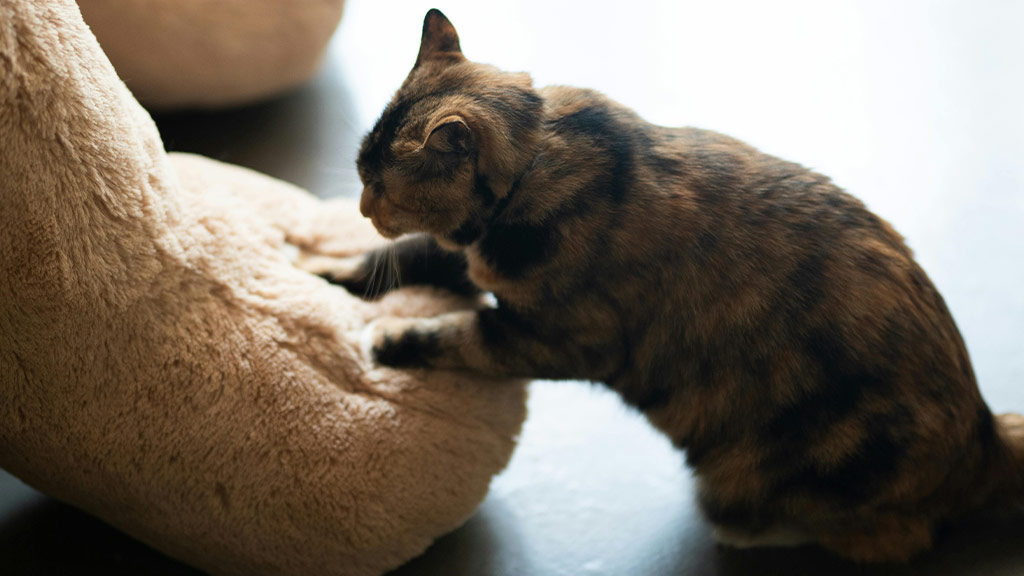Why Do Cats Make Biscuits | What does it Mean When a Cat Makes Biscuits | Why Do Cats Knead Blankets
What Does Cat Kneading Look and Feel Like | How to Stop a Cat from Kneading
Tips for Safe & Comfortable Cat Kneading
Ever noticed your cat rhythmically pressing their paws into your lap, a blanket, or even your favorite sweater?
This rhythmic pressing is a “Pure Feline Instinct” called Kneading or making biscuits. It is cats’ way of relaxing, showing affection, and claiming territory.
This naturally soothing behavior starts when they are kittens, helping them nurse from their mother. But even as they grow, the habit sticks.
Wild cats do it too, proving it’s not just a quirky house cat habit but a deep-rooted instinct.
Whether they’re marking their favorite spot or showing love, kneading is a language of comfort that every cat lover comes to recognize.
Why Do Cats Make Biscuits
The whole kneading thing goes way deeper than just a cute habit — it’s hardwired into cats’ DNA from birth.
They simply can’t resist it…
For example, my cat Sophie does this every single night when she curls up on my lap. I’ve seen how she pushes her paws in and out with this dreamy look on her face. It’s exactly the same motion she must’ve used as a tiny kitten to get milk from her mom.
The most fascinating part is that wild cats do this too — it’s not just our pampered house cats. They’re instinctively marking their territory while they knead (cats have scent glands in their paw pads).
And here’s something most people don’t know: when cats knead on you, they’re saying “You’re my person.” Pretty sweet, right?
What does it Mean When a Cat Makes Biscuits
One simple meaning for when cats start making biscuits; they’re in their happy place. Think of it like a cat’s version of a content sigh.
My older cat Max only does it when he’s super relaxed, usually right before taking a nap. It’s honestly one of the biggest compliments a cat can give you.
The interesting thing is that this behavior starts when they’re just tiny kittens, and they keep doing it their whole lives. I’ve noticed they tend to do it more on soft surfaces — blankets, pillows, your lap if you’re lucky. Sometimes they’ll even zone out while they’re doing it like they’re in some kind of peaceful trance.
What Does Cat Kneading Look and Feel Like
Having experienced this countless times with my cats, I can tell you it’s a pretty distinct motion.
Picture someone slowly pressing dough — push in, pull out, push in, pull out. The pressure can range from super gentle to surprisingly firm. My cat Bella puts her whole body into it, shifting her weight back and forth as she kneads.
Their paws spread out wide when they push down, then contract when they pull back. The feeling depends on whether their claws are involved — sometimes it’s just soft paw pads (heaven), and other times you might get a few gentle pricks (less heaven).
The rhythm is usually steady & methodical, like they’re in a meditation state.
Why Do Cats Knead Blankets
For cats, blankets are like catnip for kneading. The softer the blanket, the more they seem to love it.
My theory is that plush materials remind them of their mom’s fur — which makes total sense when you think about it.
Here’s something interesting: cats seem to prefer certain textures over others. My cat ignores smooth surfaces but goes nuts for anything fuzzy or fleece-like.
The warmth factor plays a huge role too — they’re basically creating their perfect little nest. Plus, every time they knead, they’re leaving their scent behind, marking that blanket as their territory.
How to Stop a Cat from Kneading
Trying to completely stop your cat from kneading is like stopping a river — pretty much difficult and not the best idea.
I’ve found it’s way better to redirect than restrict. My approach has been to keep a dedicated kneading blanket near their favorite spots. Sometimes I’ll gently move their paws to the blanket when they start going at my expensive couch.
The key is consistency and patience — it took my cat about a month to understand where it was OK to knead. Trimming their nails regularly makes a tremendous difference too.
Tips for Safe & Comfortable Cat Kneading
Let me share what’s worked best for me over the years.
First off, invest in a few thick, washable blankets specifically for kneading — it’ll save your furniture & your sanity. I keep one on the couch, one on my bed, & one in their favorite sunny spot.
Nail maintenance is important — I trim my cats’ nails every 2-3 weeks, which makes a massive difference. Some people swear by those soft nail caps, but I’ve never tried them myself.
Creating designated kneading spots around your house helps establish boundaries. The thickness of the padding matters too — I learned this the hard way after some claw-through incidents with thinner blankets.
Final Words!
Next time when your cat starts kneading, remember they’re doing more than just moving their paws. They are expressing trust, relaxation, and ownership.
While their claws might get a little too sharp, offering a soft blanket and keeping their nails trimmed can make the experience more enjoyable for both of you. Instead of stopping them, embrace this unique way cats communicate their emotions.
Has your cat ever surprised you with their kneading habits? Share your story in the comments—we’d love to hear all about it!
Author
-

Jasmine Charbonier is a proud cat parent with a deep understanding of feline instinctive behavior. Her passion for cats goes beyond companionship — she enjoys observing and studying their natural habits, from kneading and purring to hunting and territorial marking. With years of experience caring for and interacting with cats, Jasmine shares valuable insights into their unique behaviors, helping fellow cat lovers strengthen their bond with their pets.
View all posts

